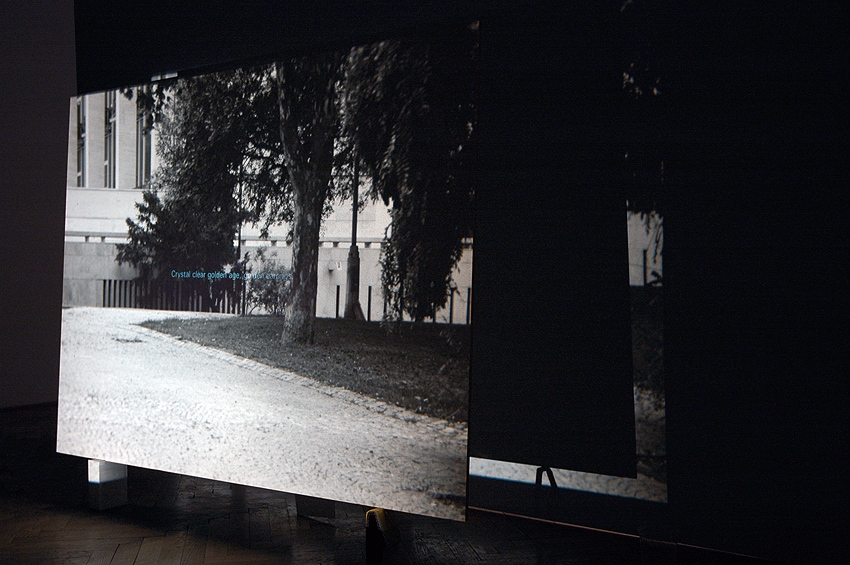4/11 2015, Den otevřených dvěří Ateliéru intermédií FaVU VUT Brno, 13:00–19:00, Údolní 19.
První ateliérová schůzka je ve středu 23/9 13:00, místnost 316 (Údolní). Prosíme o dochvilnost!
Novým vedoucím ateliéru bude od 1. září 2015 umělec Pavel Sterec.
Pavlína Míčová: Přibližuji Double Brno (Flash Art, 11–12/2009)
(English version below)
(...) Výchozím tématem instalace je samotný prostor kabinetu ve fyzické i významové rovině. „Kabinet“, obecně vnímaný jako pracovna nebo místnost pro sbírky, evokuje přízraky preparátů, nedokončených pokusů a ztracených patentů. Jedním z určujících principů kabinetu je redukce vybraných jevů, kterou lze metaforicky chápat jako jejich vychylování z běžné optiky vnímání: nad diaprojektory se ve sklenici s vodou tvoří nekonečný vír, v němž rotuje hřebík, plastové kelímky slouží jako reproduktory. Instalaci, tvořené projekcí a drobnějšími objekty, dominuje v čele místnosti projekční plocha. Podélný prostor galerie tak evokuje svými dispozicemi kinosál, kde ovšem chybí zázemí sedadel, tedy standardní divácké pohodlí (jen náhodou dříve prostor sloužil jako skutečná projekční místnost). V tomto ohledu představuje divácky „nepohodlná“ projekce metaforu recepce samotného promítání, které nenese jednoduše uchopitelnou naraci. Textové vstupy, které se obrazovými pasážemi prolínají, je bezprostředně nevysvětlují, ale jen volně doplňují.
Instalace rovněž využívá vrstvení projekční plochy a přeformátování projekce; před zadním panelem je předsazen menší, jehož obrysy skutečná velikost promítaného obrazu přesahuje tak, že tvoří jakýsi boční rám. Subtilita rozměrné instalace evokuje „vratkost“ projekční plochy, která jako by levitovala nad zemí, podložena jen provizorními podpěrkami. Vlastní projekce ze dvou diaprojektorů je soustředěna do jediného formátu. Kombinuje statické fotografie, filmové výseky, textové titulky a grafické symboly. Rytmus obou diaprojektorů je asynchronní, obraz a text se nespojují v jednotné sekvence, ale vytváří jakousi dvojjedinou syntaxi. Mizí obvyklá doprovodná role titulků, text se stává rovnocenným a částečně nezávislým obrazovým plánem. Projekce připomíná mimovolné obrazy v naší paměti, otisky obrazových vjemů, které přetrvávají, i když je už nevnímáme smysly. Je to mixáž recepce vnějšího světa s vnitřním komentářem. Prvně obdobný princip „polyekránu“ použil Cenek ve spolupráci s Terezou Sochorovou na výstavě, která byla součástí Přehlídky animovaného filmu v Olomouci (PAF) na konci roku 2008. Projekci také založil na významové i vizuální tenzi dvou diaprojektorů, z nichž jeden asynchronně promítal textové titulky a druhý černobílé fotografie. Tentokrát ale projekt povyšuje textovou složku nad doprovodnou úroveň titulků – Cenek texty vysouvá do středové části obrazu a mění rovněž jejich poetiku eliminací sdělnosti. Celek, vzniklý ve spolupráci s R. Zrubcem a G. Abrantesem, je uvozen podmanivou hudební skladbou o morálním relativismu přátelství. (...) — Pavlína Míčová
(...) The initial theme of the installation is the school workroom, both in the physical and symbolic sense. The “lab” is generally perceived to be a workroom or room for collecting, evoking phantoms of preparation and unending experimentation and lost patents. One of the defining principles of a school lab is the reduction of selected phenomena that can be metaphorically understood as a deflection from the normal optical perception: above the slide projectors there is forming an endless vortex in a glass of water, and plastic cups serve as speakers. The installation, consisting of projection and smaller objects is dominated by projection screen at the head of the room. The longitudinal gallery space also evokes a cinema but lacks the background of the seats, a standard audience comfort, (it just happens to be a space which previously served as the actual projection room).
The installation also uses layering projection screens and projection reformatting; the rear panel is smaller and the actual size of the image is larger than the projected image so they form a kind of side frame. The subtlety of the dimensions of the installations evokes the “wobbliness” of the projection screen, which sort of levitates above the ground, propped on temporary legs. The projection from two slide projectors is concentrated into a single format. It combines static images, film segments, text and graphic symbols. The rhythm of the slide projector is asynchronous, image and text in non-uniform sequence, create a doubled syntax. The usual accompanying role of subtitles disappears and the text becomes the equivalent of a partially independent image plan. The projection reminds us of reflex images in our mind’s image perceptions that persist even when you do not perceive with the senses. It’s a mixed reception of the perceived world with internal commentary. First the concept of such a “polyecran” Cenek used in cooperation with Tereza Sochorová in the exhibition, which was part of a presentation of the Festival of Film Animation in Olomouc (PAF) in December 2008. The projection also founded on the meaning and visual tension of two slide projectors, one of which asynchronously translated text captions, and the other black and white photographs. This time however the projected text heightened the level of the accompanying subtitles – Cenek moved the texts into the central part of the image and change their poetics by the elimination of communicativeness. The installation, which came about in collaboration with R. Zrubec and G. Abrantes, is emphasized by compelling sound track on the moral relativism of friendship. (...) — Pavlína Míčová
■
Info, foto: http://intermedia.ffa.vutbr.cz/galerie-kabinet-abrantes-cenek-zrubec
Přibližuji, zvětšuji / Getting closer, magnifying. Galerie Kabinet | The Cabinet Gallery, Brno
